Judgment and Decision Making, vol. 3, no. 7, October 2008, pp.
512-527
Decision making in civil disputes:
The effects of legal role, frame, and perceived chance of winningVictoria Gilliland* and John C. Dunn
School of Psychology
University of Adelaide
|
The present study investigates the effect of framing and legal role on
the propensity to accept a settlement offer by litigants in a simulated
legal dispute. Participants were given four different scenarios that
factorially combined legal role (plaintiff vs. defendant) and frame
(positive vs. negative). The results indicated that positively framed
litigants were more willing to settle than negatively framed litigants
independently of legal role. These results were replicated in a second
experiment that also asked participants to state their subjective
probability of winning. This revealed that the propensity to settle was
a joint function of frame and the perceived chance of winning. In
contrast to previous research, no systematic effect of legal role was
found. It is concluded that the rate of negotiated settlements of legal
disputes may be increased by manipulating both of these factors.
Keywords: Prospect theory, framing, legal decision making,
negotiation, role, plaintiff, defendant
1 Introduction
Litigation is expensive, particularly when the dispute continues until
the trial stage. Although figures are often shrouded in politics and
exaggeration, there is evidence that the cost of litigation has been
steadily rising by approximately 12% annually since 1980 (Luu, 1993).
More recent figures suggest that nearly 90% of U.S. businesses are
involved in litigation, with corporations engaged in an average of 37
lawsuits at any one time (Insurance Journal, 2005). Furthermore, while
only one in twenty civil disputes reach court, trials account for 50%
of all spending on litigation (Trubek, Sarat, Felstiner, Kritzer, &
Grossman, 1983). The considerable cost imbalance which exists between
disputes resolved at trial and through settlement means that a small
reduction in the number of disputes which go to trial can result in a
large reduction in the overall cost of litigation. There is therefore
significant benefit to be gained from reducing the number of civil
disputes which reach the trial stage. In the case of non-legal
disputes, such as those involving acts of terrorism or inter-state
conflict, the consequences of failed negotiation go beyond mere dollars
and cents with people’s lives also in the balance.
In order to increase the chance of a negotiated outcome, there must
first be some understanding of why negotiations fail. Early research
that focused on legal settings attempted to explain litigant behavior
through the application of economic utility models (Gould, 1973;
Posner, 1973; Shavell, 1982), a theoretical orientation that has been
favored by at least some legal practitioners (Cooter & Rubinfield,
1989). Consistent with this, U.S. Federal Court Judge Randall Rader
proposed that litigants determine the value of a lawsuit by
multiplying the probability of winning in court by the amount they are
likely to win and then subtracting the legal costs (Rader, 2000).
Based on this calculation, a settlement offer is accepted if it is
higher than the this value. By this account, negotiations fail due to
differing estimates of the probability of winning at trial by
plaintiffs and defendants.
1.1 Cognitive
processes in dispute negotiation
As is well known, economic utility models fail to take into account the
nature of the cognitive processes that intervene in decision making. It
is for this reason that attention has focused on how individuals
represent the facts of the dispute, the probabilities of different
outcomes, and the nature and value of what is at stake.
Several studies have attempted to account for the failure of
negotiations in terms of the different ways in which plaintiffs and
defendants may represent the facts of the case (e.g., Korobkin &
Guthrie, 1994; Rachlinski, 1996; van Koppen, 1990). Such studies have
focused on the effect of framing on decision making.
Introduced by Kahneman and Tversky (1979), framing refers to
alternative evaluations of outcomes in terms of either gains or losses
from a given reference point which, in turn, influences an
individual’s risk preferences. Decisions made in the
context of gains are said to be positively framed and are generally
characterized by risk aversion — that is, by a preference for a
certain outcome over a gamble of equal expected utility. In contrast,
decisions made in the context of losses are said to be negatively
framed and are characterized by risk seeking behavior, illustrated by
the rejection of a certain outcome in favor of a gamble with equal
expected utility (Kahneman & Tversky, 1983).
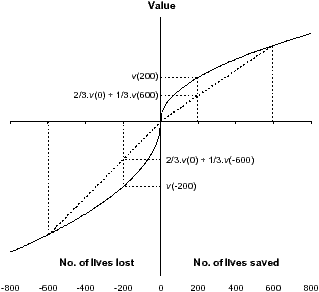
| Figure 1: Hypothetical value function illustrating the effect of
framing. For gains, expressed as the number of lives saved, the
value of the certain outcome, v(200) is greater than expected
value of the gamble, 2/3 · v(0) + 1/3 ·
v(600). For losses, expressed as the number of lives lost, the
opposite is true. |
Tversky and Kahneman (1981) illustrated the effect of framing with the
“Asian disease” problem. In this problem, participants are told to
imagine that the U.S. is preparing for the outbreak of an unusual
Asian disease, which is expected to kill 600 people. They are then
presented with a choice between two alternative programs framed either
positively or negatively. In the positive frame, participants were
given the choice was between the certain outcome that 200 people will
be saved and a risky outcome of 1/3 probability that 600 people will
be saved and 2/3 probability that no people will be saved. In this
condition, Tversky and Kahneman found that the majority of
participants preferred the certain outcome. Framed negatively, the
choice was between the certain outcome that 400 people will die
against the risky outcome of 1/3 probability that no one will die and
2/3 probability that everyone will die. In this case, they found that
the majority of participants preferred the risky outcome.
Tversky and Kahneman explained the effect of framing in terms of a
non-linear subjective value function that is monotonic and concave for
gains (lives saved) and monotonic and convex for losses (lives lost) as
illustrated in Figure 1. Because of the properties of this function,
the value of a certain gain, v(200), is greater than the value
of a gamble of equal expected utility, 2/3.v(0) +
1/3.v(600). For the same reason, the value of a certain loss
is less than the value of a gamble of equal expected utility.
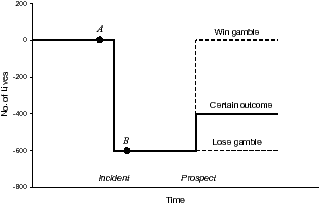
| Figure 2: Evaluation of outcomes from two reference points, A and
B. Outcomes are evaluated as losses relative to A but are
evaluated as gains relative to B. |
Although defined in terms of the expected value of the gamble, this is
not the comparison that people actually make. According to prospect
theory (Kahneman & Tversky, 1979), subjective probabilities also
undergo a non-linear transformation via a weighting function, w(p).
Called decision weights in order to distinguish them from true
probabilities, they are assumed to be used to generate the subjective
value of the two choices. Thus, for gains, the perceived value of the
certain outcome for the Asian disease problem is equal to w(1) ·
v(200), while the perceived value of the gamble is equal to w
(2/3) · v(0) + w (1/3) · v(600). If the former is
greater than the latter, then the person should be risk averse and
prefer the certain outcome to the gamble.
A critical aspect of framing concerns the ability to evaluate
prospects from different reference points. This is illustrated in
Figure 2, which demonstrates a hypothetical timeline in relation to
the Asian disease problem. The timeline involves two events, here
labeled incident and prospect. The incident
corresponds to the information that 600 lives are expected to be lost.
The prospect corresponds to the information that there are two
treatment programs each with a particular outcome structure.
Differential framing of this problem corresponds to a shift between
two reference points, labeled A and B. Point A corresponds to
the state of affairs before the incident, while point B corresponds
to the state of affairs after the incident. Relative to A, the set
of outcomes are evaluated as losses while relative to B, the same
outcomes are evaluated as gains.
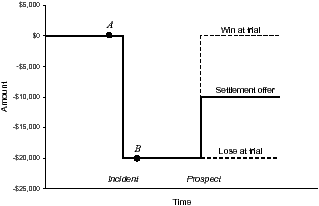
| Figure 3: Plaintiff’s evaluation of outcomes from two reference points, A and
B. Outcomes are evaluated as losses relative to A but are evaluated as
gains relative to B. |
The structure illustrated in Figure 2 may be readily extended to a
litigated dispute. This is shown in Figure 3 and corresponds to the
hypothetical scenario which we used in the two experiments to be
described later. It illustrates the set of events that confront the
plaintiff or aggrieved party in the dispute. In this case,
the incident corresponds to information that the plaintiff has lost
some amount of money (in the present scenario, this is equal to
$20,000). The prospect corresponds to a choice between a settlement
offer of $10,000 (the certain outcome) and the gamble associated with
going to court. This is presented as a 50% chance of receiving
$20,000 if they win at trial and a 50% chance of receiving nothing
if they lose at trial. However, as in the Asian disease problem, the
plaintiff may evaluate this prospect relative to two different
reference points. Relative to point A, the outcomes are evaluated as
losses while relative to point B, they are evaluated as gains.
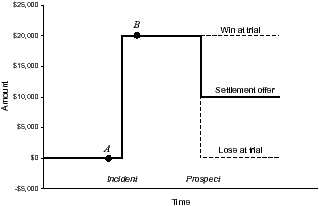
| Figure 4: Defendant’s evaluation of outcomes from two reference points, A and
B. Outcomes are evaluated as gains relative to A but are evaluated as
losses relative to B. |
Figure 4 presents the same scenario, this time from the
defendant’s point of view. In this case, the incident
corresponds to information that the defendant has acquired the
equivalent of $20,000 (the legitimacy of which is disputed by the
plaintiff), and the prospect corresponds to a choice between a
settlement offer of $10,000 and the gamble of going to court which
entails a 50% chance of paying $20,000 if they lose and a 50% chance
of paying nothing if they win. Yet the defendant may evaluate this
prospect with respect to the same two reference points as the
plaintiff. In this case, however, relative to A, the outcomes
are evaluated as gains while relative to B, they are evaluated
as losses.
1.1.1 Effects of framing on
litigation
Prior research investigating the effect of framing on litigation
outcomes has focused on the proposition that plaintiffs and defendants
tend to adopt positive and negative frames, respectively, and that this
determines their different propensities to settle. In one of the first
studies to examine this question, van Koppen (1990) presented
participants with two hypothetical scenarios involving the purchase of
a puppy. In the plaintiff scenario, participants were told that shortly
after they had paid for the puppy, it had died from a congenital defect
and that they were now suing the breeder for a refund. In the defendant
scenario, the puppy had died prior to the payment being finalized and
they were now being sued by the breeder for this payment. Although not
made explicit, van Koppen assumed that both plaintiffs and defendants
would evaluate their options from a post-incident reference point,
corresponding to B in Figures 3 and 4, and that, as a
consequence, plaintiffs would be in a positive or gain frame, while
defendants would be in a negative or loss frame. In two of four
experiments, van Koppen found the expected result; plaintiffs tended to
be risk averse and prepared to accept a relatively low fraction of the
amount in dispute while defendants tended to be more risk taking and
prepared to pay only a similarly low fraction of the disputed amount.
Although van Koppen found some results consistent with the hypothesis
that plaintiffs tend to be risk averse and defendants risk seeking,
the objective facts of the case varied between the two
scenarios, so it is not possible to attribute the observed differences
entirely to framing. In a later study, Rachlinski (1996; Experiment 1)
replicated the main result found by van Koppen using a scenario that
was closer in form to the Asian disease problem. Participants were
presented with the same legal dispute from either the plaintiff’s or
defendant’s point of view. They were then asked to choose between two
options; accepting a fixed settlement or going to trial with an
equivalent expected outcome. For example, in one scenario the amount
in dispute was $100,000 and the two alternatives were either to
accept a settlement offer of $30,000 or to go to trial where there
was a 30% chance of winning and receiving $100,000 and a 70% chance
of losing and receiving effectively nothing. Overall, the results were
consistent with differential framing of plaintiffs and defendants with
82% of plaintiffs choosing to settle compared with only 45% of
defendants.
Both van Koppen (1990) and Rachlinski (1996) presented positively
framed scenarios to plaintiffs and negatively framed scenarios to
defendants. While the results they found are consistent with the
effects of framing, they may also be attributed to effects of the
different legal roles. A potential effect of role has been highlighted
in a series of studies of two-party price negotiations conducted by
Neale, Bazerman and colleagues (Blount, Thomas-Hunt, & Neale, 1996;
Neale & Bazerman, 1985; Neale, Huber, & Northcraft, 1987). In
two-party price negotiation, two parties identify a mutually
satisfactory settlement agreement for the exchange of goods and
services. These types of transactions, such as buying a car, occur
daily and form the foundation of a market economy. Transactions of
this nature are also structurally similar to litigious negotiations in
which two parties negotiate over the value (i.e. the proposed
settlement) that should be assigned to a given legal infraction.
In the context of price negotiation research, “role” refers to the
assignment of an individual to be either a buyer or a seller. Numerous
studies have found that in power-balanced (symmetrical) negotiations,
where role is an arbitrary assignment, buyers consistently outperform
sellers. That is, buyers complete transactions of greater average
value than sellers (see for example Bazerman, Magliozzi, & Neale,
1985; Neale & Bazerman, 1985; Neale et al., 1987). To explain this,
Neale et al. (1987) suggested that adopting a role induced a
re-framing of the stakes. On this view, sellers tend to adopt a
positive frame since they stand to gain something of determinate value
(money) from the transaction while buyers tend to adopt a negative
frame since they stand to lose the same amount. Sellers therefore will
tend to be risk averse and prepared to enter into a transaction for a
lower amount than the objective value of the item in question.
Similarly, buyers will tend to be relatively risk seeking and less
prepared to pay more than the objective value of the item. The
parallel with plaintiffs, who may be viewed as sellers of their right
to sue, and defendants who may be viewed as buyers of that right, is
clear.
Neale et al. (1987) investigated the effect of frame and role by
comparing two price negotiation conditions. In the role present
condition, participants were assigned the role of either buyer or
seller and instructed to agree upon a price mix of negotiable
commodities that included discount terms, delivery time, and financing
terms. In the role absent condition, negotiators were assigned
meaningless roles (“Phrablies” and “Grizzats”) as were the
negotiable commodities, relabelled “slatkins,” “drigglers” and
“finmals.” In all other respects the two conditions were identical.
Frame was manipulated by presenting the value of the negotiable
commodities in terms of profits (positive frame) or in terms of
expenses (negative frame). In the role absent condition, there was an
effect of frame but no effect of role. Negotiators in a positive
frame were relatively risk averse and completed more transactions at a
lower average profit than negotiators in a negative frame. In the role
present condition, similar results were found only for number of
transactions completed. However, in this condition, buyers generated
more profit per transaction than sellers and for both roles there was
no effect of frame. This result suggests that adopting a socially
defined role may affect negotiation behaviour independently of frame.
To the extent that similar factors may be at work in litigation, it
suggests that the effect on decision making of being a plaintiff or
defendant may be independent of the different ways of framing the
outcomes.
In order to distinguish the effects of role and frame, it is necessary
to vary frame for both plaintiffs and defendants. One previous study
by Korobkin and Guthrie (1994) attempted to do this for plaintiffs. In
this study, participants were told that they had been involved in a
motor vehicle accident in which they had sustained damages worth
$28,000 and that according to their lawyer they would receive either
$10,000 or $28,000 at trial, depending on how the judge interpreted
a clause in the relevant insurance policy. They were also told that
the defendant (the insurance company) had made a final offer of
$21,000, and were asked to indicate whether they would accept such an
offer. Participants were then given further information that placed
them into either a positive or negative frame. In the positive frame,
participants were told that their total damages consisted of $14,000
in medical bills that had already been paid by their health insurance
fund and a further $14,000 corresponding to the value of their motor
vehicle. In the negative frame, participants were told that their
total damages consisted of $4,000 in medical bills that had already
been paid by their health insurance fund and a further $24,000
corresponding to the value of their motor vehicle. Faced with these
alternatives, Korobkin and Guthrie found that 90% of positively
framed plaintiffs would either probably or definitely accept the
offer, while only 64% of the negatively framed plaintiffs responded
in the same way.1
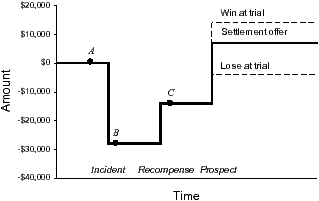
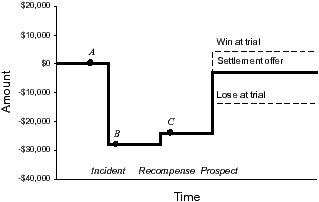
| Figure 5: Outcome structures used by Korobkin &
Guthrie (1994). (a) Positive or gain frame. (b) Negative or loss
frame. |
Although Korobkin and Guthrie concluded that framing can alter a
plaintiff’s propensity to settle, their results are not easily
interpreted for two reasons. First, for both frames, the reference
point is ambiguous and, second, from any reference point, the nature
of the outcomes objectively differs between frames. Figure 5 presents
the structures of the positive and negative frames used by Korobkin
and Guthrie (1994) in the same form as shown in Figures 2 to 4. It is
apparent that, unlike the Asian disease problem, the scenarios used by
Korobkin and Guthrie create three events on the timeline. These are
defined by the incident, corresponding to the total damages incurred
through the accident, initial recompense of medical bills, and the
final prospect. As a result, there are three distinct reference
points, A, B, and C, and only from point A do the outcomes of
the prospect differ between the two frames. This means that if the
difference in settlement rates is to be attributed to the difference
in framing, it can only be because some proportion of participants
chose to evaluate the prospect from the pre-incident point A. The
problem is that there is nothing in the scenario which would suggest
that they should do this and, if they were to do so, it would
contradict the interpretation offered by both van Koppen (1990) and
Rachlinski (1996) of their results for which they assumed that
plaintiffs would evaluate the prospect from the post-incident point
B (or C). Furthermore, it is also apparent that from any of the
three reference points, the values of the outcomes differed between
the two framing conditions. It is therefore difficult to attribute the
results to the effect of framing alone.
1.1.2 The present study
Studies of the effect of framing on litigation have not yet
satisfactorily resolved two questions. The first concerns the issue of
whether plaintiffs and defendants are bound by the role they play to
adopt a positive and negative frame, respectively, or whether they can
be induced to adopt alternative frames. In terms of the structures
shown in Figures 3 and 4, this question asks whether it is possible for
litigants to alter their point of reference from the post-incident
point B to the pre-incident point A. The second
question concerns whether the effect of legal role is completely
reducible to an effect of framing or whether, as suggested by the
results of Neale et al. (1987), the explicit roles of plaintiff and
defendant affect decision making independently of how the dispute is
framed.
In the present study, participants received a questionnaire containing
four different legal scenarios each of which dealt with a civil dispute
over the sum of $20,000. Each scenario was presented in one of four
forms defined by the factorial combination of legal role, plaintiff vs.
defendant, and frame, positive vs. negative. For plaintiffs, positively
framed scenarios described potential outcomes in terms of gains
relative to the situation following the initial loss of income,
corresponding to point B in Figure 3. Negatively framed
scenarios, on the other hand, described potential outcomes in terms of
losses relative to the situation that would have been obtained had the
initial loss of income not occurred, corresponding to point A
in Figure 3. For defendants, positively framed scenarios described
potential outcomes in terms of gains relative to the situation that
would have been obtained had the initial increase in income not
occurred, corresponding to point A in Figure 4. Negatively
framed scenarios described potential outcomes in terms of losses
relative to the situation following the increase in income,
corresponding to point B in Figure 4. In each scenario,
participants were told that a single settlement offer of $10,000 was
on the table. They were also told that if this offer was rejected and
the case went to trial, there was a 50% chance of either being awarded
or having to pay the entire sum of $20,000 and a 50% chance of being
awarded or having to pay nothing. Participants read each scenario in
turn and were asked if they would accept or reject the settlement
offer. We expected to find an effect of both role and frame on the
decision to settle, however the size of these effects and the nature of
their interaction was unknown.
2 Experiment 1
2.1 Method
2.1.1 Participants
The participants were 170 psychology students at the University of
Adelaide who received course credit for their participation. They were
aged between 17 and 44 (M = 19.5, SD = 3.7) and were
randomly assigned to one of four groups.
Participants completed a questionnaire consisting of four legal
scenarios. (Excerpts are in the Appendix, in the versions used in
Experiment 2.) Each scenario was presented in one of four test
conditions defined by the factorial combination of role (plaintiff or
defendant) and frame (positive or negative). Thus, each scenario could
be presented to participants either as a positively framed plaintiff
(P+), a negatively framed plaintiff (P–), a positively framed
defendant (D+) or a negatively framed defendant (D–). The assignment
of scenarios to each role/frame combination was counterbalanced across
four different versions of the questionnaire. In each version, the
four scenarios were always presented in the same order. In version 1,
the order of conditions was P+, P–, D–, D+. The order was D–, D+,
P+, P– in version 2, P–, D–, D+, P+ in version 3, and D+, P+, P–,
D– in version 4.
Each scenario outlined the facts of a legal dispute which could
plausibly be presented in both positive and negative frames for both
the plaintiff and the defendant. The first scenario involved a
defamation claim between a shop owner and a newspaper. The second
scenario outlined a property dispute between an investor and a
bed-and-breakfast operator. The third scenario was a contractual
dispute between two business partners regarding entitlement to income.
The fourth scenario described an inheritance dispute between two
cousins. In each case, it was stated that the plaintiff was suing the
defendant for $20,000, and that the chance of winning at trial was
50%. If the plaintiff won at trial then the defendant would have to
pay the full $20,000. Alternatively, if the plaintiff lost at trial
then the defendant would have to pay nothing. For simplicity, there
were no legal costs associated with the case. Each participant was told
that a settlement offer of $10,000 had been made and they were asked
if they would be prepared to accept it.
Each scenario established the relevant legal role by means of an initial
statement of the form: “You are the plaintiff/defendant
in a litigation suit…” The relevant frame was
established through alternative wording of the trial outcomes and the
offer. For example, in the first scenario, the trial outcome in the P+
condition is described as follows,
“Your lawyer has estimated that you have a 50% chance
that the judge will rule in your favor and your will receive $20,000
in compensation and a 50% chance that the judge will rule against you
and you will receive nothing in compensation”
Similarly, the settlement offer in this condition is described in the
following way,
“If you accept this offer, you will receive $10,000
in compensation”
In the D– condition, the phrase, “receive … in compensation”,
was replaced by the phrase “pay … in compensation”. In the P–
condition, this phrase was replaced by the phrase, “lose … in
income”, while in the D+ condition, it was replaced by the phrase,
“keep … in new income”.
2.1.3 Design and Procedure
Participants were randomly allocated to one of four groups corresponding
to the version of the questionnaire they received. They were asked to
read and respond to all four scenarios in the order in which they were
presented. They were instructed to consider each scenario separately
and to make their decision solely on the basis of the details provided,
without regard to legal fees or court costs. They were also asked not
to view the scenarios as moral dilemmas, as both plaintiffs and
defendants would feel that their position was correct.
2.2 Results
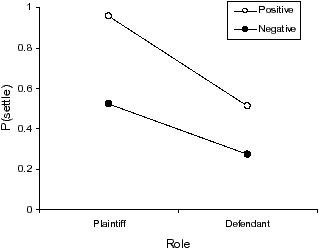
| Figure 6: Proportion of settlement
acceptances as a function of legal role (plaintiff vs. defendant) and
frame (positive vs. negative) averaged across scenarios in Experiment
1. The probability of settlement was 0.77 and 0.49 for plaintiffs in a
positive and negative frame, respectively. For defendants in positive
and negative frames, the probability of settlement was 0.70 and 0.43,
respectively. |
Figure 6 shows the overall proportion of accepted settlements averaged
over scenario as a function of legal role and frame. The data were
analyzed using logistic regression in which each response was treated
as an independent observation.2 This analysis revealed a significant effect of frame,
χ2 (1) = 54.18, p < 0.0001, with litigants in a positive
frame being more likely to settle than litigants in a negative frame,
whether they were a plaintiff or a defendant. There was no overall
effect of either scenario, χ2(3) = 2.46, p = 0.482, or role,
χ2 (1) = 3.49, p = 0.062, and none of the interactions between
frame and any other variable was significant (all p’s greater than
0.1). However, we did find an unexpected interaction between role and
scenario, χ2(3) = 35.81, p < 0.0001.
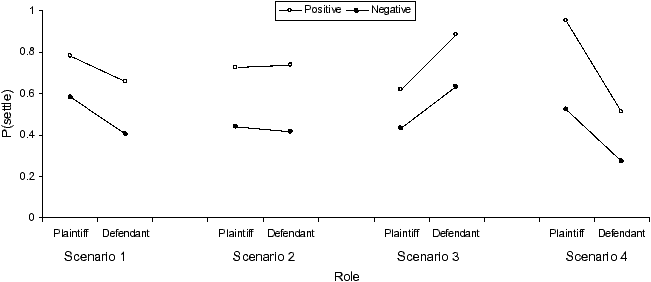
| Figure 7: Proportion of settlement acceptances as a function of
legal role and frame for each scenario in Experiment 1. |
The interaction between legal role and scenario is shown in Figure 7
which plots the proportion of accepted settlements as a function of
legal role and frame separately for each scenario. Analysis of each
scenario revealed a significant effect of role in Scenario 1, χ2
(1) = 4.20, p = 0.040, with plaintiffs more likely to settle than
defendants; a non-significant effect in Scenario 2, χ2
(1) = 0.004; a significant effect in Scenario 3, χ2
(1) = 10.82, p = 0.001, with defendants more likely to settle than
plaintiffs; and a significant effect in Scenario 4, χ2
(1) = 24.20, p < 0.0001, with plaintiffs more likely to settle
than defendants. The effect of frame was significant in all four
scenarios and the interaction between role and frame was significant
only in Scenario 4, χ2 (1) = 5.15, p < 0.023.
Experiment 1 revealed three main results. First, consistent with
prospect theory, the decision to settle a simulated legal dispute is
strongly influenced by frame. In all four scenarios, a litigant in a
positive frame was more likely to accept the settlement offer than a
litigant in a negative frame. When induced to be in a positive frame
and thereby choosing between gains, participants in this study were
consistently risk averse — that is, they were more likely to accept
the settlement offer (certain outcome) and less likely to go to trial
(uncertain outcome). Conversely, negatively framed participants,
choosing between losses, were more risk taking — they were less likely
to accept the settlement offer and more likely to go to trial. While
this finding is broadly consistent with previous research (for example
Korobkin & Guthrie, 1994; Rachlinski, 1996; van Koppen, 1990), this is
the first demonstration of an effect of framing that is independent of
role while holding the objective facts of the case constant.
As well as being consistent across all four scenarios, the effect of
frame was also substantial, with the overall proportion of acceptances
increasing from 0.46 for litigants in a negative frame to 0.74 for
litigants in a positive frame. This demonstrates that it is possible to
induce a considerable change in the behavior of both plaintiffs and
defendants by manipulating how each frames the dispute. This is
consistent with the finding in other fields of negotiation that framing
could play a role in both the exacerbation or resolution of conflict
(see for example Neale & Bazerman, 1992).
The second main result is that the effect of legal role on the decision
to settle was independent of the effect of frame. This is inconsistent
with the view that plaintiffs are always more risk averse than
defendants and thus more likely to settle (e.g., van Koppen, 1990;
Rachlinski, 1996).
The third main result was unexpected. Although there was little or no
overall difference between plaintiffs and defendants in their
propensity to settle, the effect of legal role varied considerably
between the different scenarios. In fact, in marked contrast to the
view that plaintiffs are always more risk averse than defendants, the
results for Scenario 3 showed that it is possible, under some
circumstances, for plaintiffs to be less likely to settle than
defendants, independently of how they frame the dispute. A
superficially similar result was reported by Guthrie (2000) who found
that defendants were more willing to settle than plaintiffs in
“frivolous” litigation, in which plaintiffs have little or no chance
of winning at trial. In this case, according to prospect theory,
plaintiffs over-weight their small probability of winning while
defendants under-weight their high probability of winning, leading to
a preference inversion. However, this mechanism does not directly
explain the present results since both plaintiffs and defendants were
told that they had equal chances of winning at trial.
Although the probability of winning at trial was fixed at 50%, it may
have been possible that participants departed from this amount in
estimating their own subjective probability of winning, although not
to the extent examined by Guthrie (2000). This estimation could have
been based on the content of each scenario and the participants”
general knowledge and experience of the law. If there were systematic
differences between scenarios in the subjective chance of winning at
trial, this would affect settlement rates and could account for the
variable effect of role. Experiment 2 investigated this possibility by
asking participants to provide estimates of their chance of winning at
trial.
3 Experiment 2
3.1 Method
3.1.1 Participants
The participants in this study were 408 psychology students from the
University of Adelaide who participated in order to receive course
credit. They were aged between 16 and 39 (M = 19.6,
SD = 4.03) and were randomly assigned to one of 8 groups
depending upon the version and type of questionnaire they received (see
below).
This experiment used the same questionnaires containing the same four
legal scenarios and instructions as used in Experiment 1. The only
difference was that participants were asked the following question:
“Your lawyer has advised that you have a 50% chance of
winning in court. Based on the details provided, what chance (as a
percentage) do YOU think you have of winning in court?”
There were four versions of each questionnaire as in Experiment 1. In
addition, there were also two types of questionnaire. In type A, the
question above was asked immediately following the request for the
participant to decide whether or not to accept the settlement offer.
In type B, the question was asked before the request was made for the
participant to decide to accept or to reject the settlement
offer3.
3.1.3 Design and Procedure
Participants were randomly allocated to one of 8 groups defined by the
combination of the two types and four versions of the questionnaire.
Otherwise, the procedure was identical to that used in Experiment 1.
3.2 Results and Discussion
Figure 8 shows the proportion of accepted settlements averaged over
scenario as a function of questionnaire type, legal role, and frame.
The pattern of results is similar to that found in Experiment 1. The
data were analyzed using logistic regression with factors of
questionnaire type, scenario, role, and frame.4 This revealed a significant effect of frame,
χ2 (1) = 64.05, p < 0.0001, and, in contrast to Experiment
1, a significant effect of role, χ2 (1) = 10.55, p = 0.001.
The interaction between scenario and role was also significant,
χ2(3) = 199.62, p < 0.0001, as in Experiment 1. However,
unlike in Experiment 1, there was a significant interaction scenario
and frame, χ2 (1) =
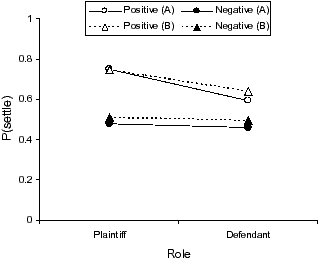
| Figure 8: Proportion of settlement acceptances as a function of
questionnaire type (A vs. B), legal role (plaintiff vs. defendant), and
frame (positive vs. negative) averaged over scenarios in Experiment 2.
The probability of the plaintiff settling was 0.75 and 0.50 for
positive and negative frames, respectively. The probability of the
defendant settling was 0.63 in the positive frame and 0.49 in the
negative frame. |
14.21, p = 0.003. No other main effects or
interactions were significant.
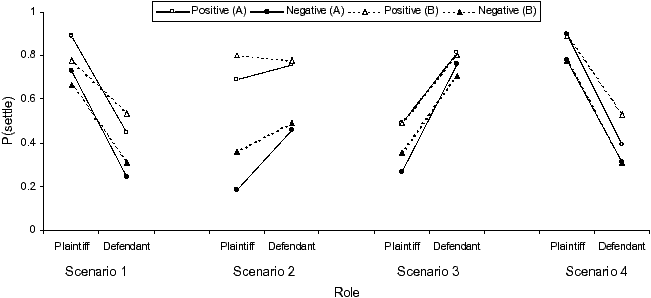
| Figure 9: Proportion of settlement acceptances as a function of
questionnaire type, legal role, and frame for each scenario in
Experiment 2. |
Figure 9 shows the pattern of results for each scenario and reveals
the variable effect of role and frame across the four scenarios.
Separate analyses of questionnaire type, role, and frame for each
scenario revealed that the effect of frame was significant in all four
scenarios, χ2 (1) = 13.13, 63.12, 7.50, and 9.96, respectively.
In each case, a positively framed litigant was more likely to settle
than a negatively framed litigant. In contrast to Experiment 1, the
effect of role was significant (p < 0.02) in all four scenarios,
χ2 (1) = 61.31, 6.60, 58.72, and 88.34, respectively. Plaintiffs
were more likely than defendants to settle in Scenarios 1 and 4, and
less likely to settle in Scenarios 2 and 3. No other effect was
significant (p < 0.01) in any scenario.
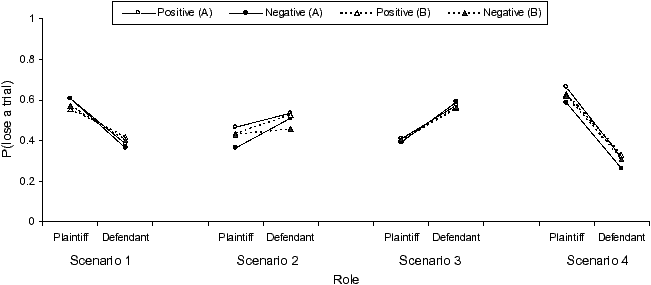
| Figure 10: Average subjective probability of losing at trial as
a function of questionnaire type, legal role and frame for each
scenario. |
Despite being informed that there was always a 50% chance of winning
at trial, participants provided a wide range of estimates for what
they believed to be the actual chance. Figure 10 shows the average
subjective probability of losing at trial as a function of
questionnaire type, role, and frame for each scenario. These estimates
covered the full range from zero to one and were approximately
normally distributed with an overall mean of 0.476 and a standard
deviation of 0.197. Analysis of variance revealed a main effect of
frame, F(1,1600) = 7.81, MSE = 2166.1, p = 0.005,
with a positive frame leading to a greater subjective probability of
losing than a negative frame (M = 0.488 and M =
0.465, respectively). There was also a main effect of role,
F(1,1600) = 60.39, MSE = 16742.1, p < 0.0001,
with plaintiffs perceiving themselves as having a greater chance of
losing than defendants (M = 0.509 and M = 0.444,
respectively). As Figure 10 also shows, the interaction between
scenario and role was highly significant, F(3,1600) = 188.85,
MSE = 52360.6, p < 0.0001. No other effects were
significant.
The present data also show evidence of a self-serving bias — the
propensity for individuals in a given role to over-estimate their
probability of winning at trial. In order to investigate this, the
defendant’s subjective probability of losing was converted into the
subjective probability of winning which corresponds to the defendant’s
subjective probability that the plaintiff should lose. Any effect of
role in the analysis of these data would indicate a self-serving bias
(or its opposite). Analysis of variance revealed such a main effect,
F(1,1600) = 32.0, MSE = 8871.3, p < 0.0001, with
plaintiffs estimating their chance of losing as being less than that
estimated by defendants (M = 0.509 and M = 0.556,
respectively). There was also a small but significant interaction
between role and frame, F(1,1600) = 7.81, MSE = 2166.1, p
< 0.01, with frame affecting plaintiffs’ perceived chances of
losing (Ms = 0.527 and 0.489 for positive and negative
frames, respectively), while having little or no effect on defendants’
perceived chance of the plaintiffs losing (Ms = 0.558 and
0.553 for positive and negative frames, respectively).
It is clear from a comparison of Figures 9 and 10 that variability in
the effect of role on the probability of accepting a settlement across
scenario is strongly related to corresponding variation in the
subjective probability of losing at trial. For both plaintiffs and
defendants, a high perceived chance of losing at trial is correlated
with an increased chance of accepting the settlement offer. In order
to test this hypothesis more formally, the data from Experiment 2 were
re-analyzed using subjective probability of losing (or winning) as a
covariate. This revealed, as expected, that perceived probability of
winning is a very strong predictor of settlement, χ2 (1) =
533.5, p < 0.0001. Furthermore, once variation in subjective
probability has been controlled for, the main effect of role is
completely eliminated, χ2 (1) = 0.03, p = 0.873. In contrast,
the effect of frame remains significant, χ2 (1) = 68.78,
p < 0.0001, as is the interaction between frame and scenario,
χ2 (3) = 11.06, p = 0.011. There is now a significant main
effect of scenario, χ2 (3) = 8.67, p = 0.034, and the
interaction between scenario and role, while much reduced, remains
statistically significant, χ2 (1) = 18.9, p < 0.001.
Analysis of the individual scenarios revealed a similar pattern, with
subjective probability highly significant (p < 0.001) in
all scenarios. When the effect of this covariate is removed, the
effect of frame remains significant (p < 0.01) in three of the
four scenarios, χ2 (1) = 14.68, 54.2, 10.37 and 6.58,
respectively. The effect of role, while still significant (p <
0.01) in two of the four scenarios, was substantially reduced, χ2
(1) = 6.65, 0.10, 9.10 and 4.96, respectively. The interaction
between role and frame is not significant (p < 0.01) in any
scenario.
3.2.1 The effects of role, frame, and perceived chance of
losing
It is possible to combine the results of Experiment 2 in a single figure
that demonstrates the effects of role, frame, and perceived chance of
winning on the probability of accepting the settlement offer. According
to prospect theory, the offer will be accepted if its subjective value
is greater than the subjective value of going to trial. An individual
in a positive frame, whether plaintiff or defendant, should therefore
settle if,
w(1) · v($10,000) > w(p) · v($20,000) + w(1−p)
· v($0)
where v(.) is a subjective value function that takes a quantity
(money in this case) as its argument, and w(.) is a weighting
function applied to the subjective probability of winning at trial,
p. According to Kahneman and Tversky (1979), people tend to
assign greater weight or importance to probabilities close to zero and
relatively less importance to probabilities close to one. A similar
equation can be written for an individual in a negative frame. In this
case, such an individual should settle if,
w(1) · v(−$10,000) > w(p) · v(−$0) + w(1−p) ·
v(−$20,000)
In other words, they will settle if the perceived value of the
settlement offer is greater than the expected value of going to trial.
This, in turn, is determined by the weighted subjective probability of
winning at trial, and losing nothing, and the weighted subjective
probability of losing at trial and losing the full amount.
In the present study, the objective values of the settlement offer,
$10,000, and the award, $20,000, were both fixed. According to
prospect theory, the subjective values of these quantities are
therefore also fixed for a given individual. We assume that these
values are also fixed across individuals. This means that, after
re-arranging the terms in the above equations5, for an individual in
a positive frame, the settlement offer will be accepted whenever,
while, for an individual in a negative frame, the offer will be accepted
whenever,
As Figure 10 shows, the average subjective probability of losing at
trial varies across the set of conditions defined by the levels of
role, frame, and scenario. We assume that within each such condition,
subjective probability is approximately normally distributed with a
mean and standard deviation corresponding to the observed mean and
standard deviation for that condition. We also assume, as a first
approximation6, that w(p) = p. In this
case, the above two equations can be expressed in terms of the
subjective probability of losing, q = 1 − p. Thus, an individual
in a positive frame should settle whenever q > 1 − r+,
and an individual should settle whenever q > r−, from which
it follows that, if (1 −r+) < r−, then a framing effect
will be observed.7 According to prospect theory, the value
function, v(.), is concave for gains and convex for losses which
means that r+ > 0.5 and r− > 0.5. Therefore,
prospect theory predicts that (1 − r+) < r−.
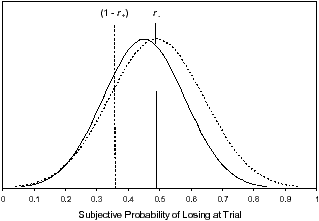
| Figure 11: Hypothetical distributions of the subjective probability of
losing at trial in relation to settlement criteria for positively
framed (dashed line) and negatively framed (solid line) judgments.
The probability of settling in each distribution is given by the
area to the right of the corresponding criterion, (1 − r+) for
positively framed judgments and r− for negatively framed
judgments. |
Figure 11 illustrates the proposed relationship between framing,
subjective probability of losing at trial, and the probability of
accepting the settlement offer. The distribution indicated by a dashed
line describes the probability of losing at trial in a positively
framed condition of the present experiment. The distribution indicated
by a solid line describes the probability of losing at trial in a
negatively framed condition corresponding to the same scenario, role,
and questionnaire type. The distributions are shown as being slightly
different to accommodate the finding that the perceived chance of
losing was greater when in a positive frame than when in a negative
frame. The variances of the two distributions may also differ. The two
vertical lines correspond to the criteria, (1 – r+) and r−,
defined above. According to the proposed model, the probability of
accepting the settlement offer in the positively framed condition is
equal to the area under the corresponding distribution to the right of
the positive criterion, (1 − r+). Similarly, the probability of
accepting the settlement offer in the negatively framed condition is
equal to the area under the corresponding distribution to the right of
the negative criterion, r−. For the purposes of fitting this
model, we assumed that subjective probability was normally distributed
within each condition, defined by a unique combination of
questionnaire type, scenario, role, and frame, and that the two
criteria, r+ and r−, were independently normally distributed
with a constant standard deviation across conditions. This has the
effect of augmenting the variance of each distribution of subjective
probability in each condition by a fixed amount.8 Let mi and si be the mean and the
augmented standard deviation of the subjective probability of losing
at trial for condition i. Let pi be the probability of accepting
the settlement offer in condition i, and let Φ(.) be the
normal cumulative distribution function. Then, for positively framed
conditions, pi = Φ (1 − r+ − mi)/si, while for
negatively framed conditions pi = Φ (r− − mi)/si.
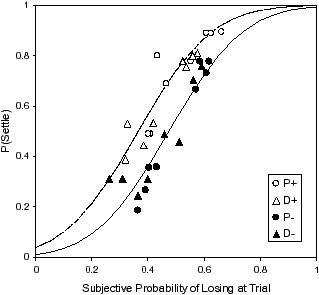
| Figure 12: The probability of accepting the settlement
offer as function of role, frame, and the subjective probability of
losing for each scenario and questionnaire type. The dashed line shows
the best fitting constant variance function for positively framed
conditions. The solid line shows the best fitting constant variance
function for negatively framed conditions. |
Figure 12 shows the observed probability of accepting the settlement
offer as a function of the subjective probability of losing at trial
for each combination of role, frame, scenario, and questionnaire type.
The model fit the data reasonably well, χ2 (29) = 40.97, p =
0.069, although, as Figure 12 shows, there are features of these data
that it fails to capture. Figure 12 also shows two curves
corresponding to functions that approximate the fitted model. For
these functions, displayed for illustrative purposes only, the
variance was constrained to be constant across all conditions (i.e.,
si = s for all i). Since variance estimates did not differ
substantially between the different conditions, these functions also
fit the data quite well. The dashed line corresponds to positively
framed conditions while the solid line corresponds to negatively
framed conditions derived from the best fitting maximum likelihood
estimates of r+ and r−, respectively. These values were
found to be 0.634 and 0.475, and, according to the derivations given
above, may be interpreted as the relative value of a gain or loss of
$10,000 compared to a similar gain or loss of $20,000. The values
that we obtained indicate that for this sample of participants and
conditions, a gain of $10,000 is perceived as equivalent to 63.4% of
a gain of $20,000 while a loss of $10,000 is perceived as equivalent
to 47.5% of a loss of $20,000. The estimate of r+ is thus
consistent with prospect theory which proposes that the subjective
value function is negatively accelerating for gains. The estimate for
r− is not as consistent since it is less than 0.5 and thus
indicates a negatively, rather than positively, accelerating value
function for losses. However, the estimate is very close to 0.5 and,
if the true value is slightly greater than 0.5, this would be
consistent with the proposal from prospect theory that the value
function for losses is both positively accelerating and relatively
steeper (i.e., accelerating less) than the value function for gains.
Figure 12 also illustrates two additional effects. First, it
demonstrates the general trend for participants to become less risk
taking as their subjective probability of losing increases. This agrees
with both prospect theory and commonsense — if you think you are going
to lose at trial then, if you are the defendant, you are more likely to
pay a relatively higher sum to settle and, if you are the plaintiff,
you are more likely to accept a relatively smaller sum to settle. Yet,
these results directly contradict the conclusion reached by van Koppen
(1990) that litigants become more risk taking as their subjective
probability of losing increases. The present finding is also
inconsistent with Guthrie (2000), who proposed that risk preferences
are a function of only role and the probability of losing.
The second effect shown by Figure 12 concerns the relative effects of
framing and legal role. One of the principal results of the present
study is that while there is a consistent effect of framing on the
probability of accepting the settlement offer across all scenarios,
there is no overall effect of role. However, that being said, there
remains a significant interaction between role and scenario, even after
accounting for differences in the perceived chance of losing. As the
data shown in Figure 12 suggests, their may be a residual effect of
role in different scenarios. In this case, role may interact in
idiosyncratic ways with the contents of the particular case to affect
propensity to settle independently of the perceived chance of losing.
This appears to be most apparent in Figure 12 in relation to the two
data points corresponding to D–. These points both relate to Scenario 4
and suggests that there is something about the content of this scenario
that encourages defendants to settle over and above the effects of
framing or the perceived chance of losing. We can offer no obvious
explanation for this particular effect.
4 Conclusions
The principal result of the present study is that the likelihood of
accepting an offer to settle out of court is determined by two factors;
the frame or reference point from which the offer is evaluated and the
subjective probability of losing (or winning) at trial. This is the
first study that examined the effect of frame independently of role and
helps to clarify the results of earlier studies of decision making by
litigants. In two experiments involving over 500 participants,
plaintiffs and defendants were equally susceptible to framing
manipulations, a result that is inconsistent with the view that
plaintiffs are always be risk-averse and defendants are always
risk-seeking. Although it may very well be the case that plaintiffs
will tend to adopt a gain frame and defendants similarly a loss frame,
the present results suggest that this is not immutable and that some
latitude exists to re-frame the respective parties. In so doing, the
likelihood of reaching a settlement may increase, particularly if the
defendant can be induced to adopt a positive or gain frame. It is
important to note, however, that no attempt was made in the present
study to place plaintiffs and defendants in different frames within the
same dispute. Rather, individuals were asked to evaluate a fixed
settlement offer in one of the two roles. To pursue this question
further, it would be necessary to place plaintiffs and defendants
involved in the same dispute into different frames in a manner
analogous to similar work in the area of two party price negotiations
(see for example Neale & Bazerman, 1992).
We were able to manipulate frame relatively easily in the present study
as the participants were all involved in simulated legal disputes. As
is the problem with most applied research conducted in the laboratory,
it is unclear the extent to which participants took on the roles they
were given, and how easy it would be to manipulate frame in real
disputes. It is also unclear what effect the instruction to disregard
legal fees had on participants and how this might be different for real
litigants. Further research is required to determine the extent to
which actual litigants adopt variable reference points in their
evaluations, the extent to which these are fixed or are labile
throughout negotiations, and how easily they may be influenced by third
parties, such as lawyers.
References
Bazerman, M. H., Magliozzi, T., & Neale, M. A. (1985). Integrative
Bargaining in a Competitive Market. Organizational Behavior and
Human Decision Processes, 35, 294–313.
Blount, S., Thomas-Hunt, M. C., & Neale, M. A. (1996). The Price Is
Right - Or Is It? A Reference Point Model of Two-Party Price
Negotiations. Organizational Behavior and Human Decision
Processes, 68, 1–12.
Cooter, R. D., & Rubinfield, D. L. (1989). Economic analysis of legal
disputes and their resolution. Journal of Economic Literature,
27, 1067–1097.
Gould, J. P. (1973). The Economics of Legal Conflicts. Journal
of Legal Studies, 2, 279–300.
Guthrie, C. (2000). Framing Frivolous Litigation: A Psychological
Theory. University of Chicago Law Review, 67, 163–216.
Insurance Journal. (2005). Cost of Litigation Haunts US Corporations
More Than Winning Cases. November 7 2005. Retrieved 6 December 2007,
2007, from
http://www.insurancejournal.com/magazines/east/2005
/11/07/features/62312.htm
Kahneman, D., & Tversky, A. (1979). Prospect Theory: An Analysis of
Decision Under Risk. Econometrica, 47, 263–291.
Kahneman, D., & Tversky, A. (1983). Choices, Values and Frames. In D.
Kahneman & A. Tversky (Eds.), Choices, Values and Frames (pp.
1–17). New York: Cambridge University Press.
Korobkin, R., & Guthrie, C. (1994). Psychological Barriers to
Litigation Settlement: An Experimental Approach. Michigan Law
Review, 93, 107–192.
Luu, T. N. (1993). Reducing the Costs of Civil Litigation. Retrieved 6
December 2007, 2007, from
http://w3.uchastings.edu/plri/fal95tex/cstslit.html
Neale, M. A., & Bazerman, M. H. (1985). The Effects of Framing and
Negotiator Overconfidence on Bargaining Behaviors and Outcomes.
Academy of Management Journal, 28, 34–49.
Neale, M. A., & Bazerman, M. H. (1992). Negotiating rationally: the
power and impact of the negotiator’s frame.
Academy of Management Executive, 42–51.
Neale, M. A., Huber, V. L., & Northcraft, G. B. (1987). The framing of
negotiations: contextual versus task frames. Organizational
Behavior and Human Decision Processes, 39, 228–241.
Posner, R. A. (1973). An Economic Approach to Legal Procedure and
Judicial Administration. Journal of Legal Studies, 2,
399–458.
Rachlinski, J. J. (1996). Gains, Losses and the Psychology of
Litigation. Southern California Law Review, 70, 113–185.
Rader, R. (2000). The Pace and Expense of Litigation in United States
Courts. Retrieved December 6, 2007, from
http://www.law.washington.edu/CASRIP/Symposium
/Number5/
Shavell, S. (1982). The Social versus the Private Incentive to Bring
Suit in a Costly Legal System. Journal of Legal Studies,
11, 333–339.
Trubek, D. M., Sarat, A., Felstiner, W. L. F., Kritzer, H. M., &
Grossman, J. B. (1983). The Costs of Ordinary Litigation. UCLA
Law Review, 31(72–127).
Tversky, A., & Kahneman, D. (1981). The Framing of Decisions and the
Psychology of Choice. Science, 211, 453–458.
van Koppen, P. J. (1990). Risk taking in civil law negotiations.
Law and Human Behaviour, 14, 151–165.
Appendix: Selections from scenarios
Scenario 1: Plaintiff (positive frame)
You are the plaintiff in a litigation suit, for which the details are
as follows. You are the owner of a small gourmet deli. Recently, a
local newspaper published a series of articles entitled “Are
these the city’s worst employers?” The articles discussed a number
of small businesses in the area and accused them of underpaying their
staff and providing sub-standard working conditions. While no names
were given, you feel that as a consequence of these articles,
customers stayed away and your business suffered $20,000 in lost
income.
You have been to see your lawyer and he has advised that you have a
claim for restitution. Your lawyer has entered into negotiations with
the newspaper on your behalf. You are seeking $20,000 in
compensation. The newspaper denies the claim on the basis that they
did not identify your business, and that the descriptions given in the
articles could have referred to any number of businesses.
You have been involved in lengthy legal negotiations with the
newspaper and no settlement has been reached. You have decided to
pursue the matter in court and a trial date has now been set. Your
lawyer has advised that the success of your case depends on whether or
not the judge feels you can be definitively identified from the facts
given in the articles. Your lawyer has estimated that you have a 50%
chance that the judge will rule in your favour and you will receive
$20,000 in compensation and a 50% chance that the judge will rule
against you and you will receive nothing in compensation.
The night before the trial is due to begin, your lawyer calls to tell
you that the newspaper has offered to settle out of court. If you
accept this offer, you would receive $10,000 in compensation. This is
the final offer before the trial and your decision must be made before
the morning.
Will you accept the offer? [yes] [no]
Your lawyer has advised that you have a 50% chance of winning in
court. Based on the details provided, what chance (as a percentage) do
YOU think you have of winning in court?
Approximately _______% chance of winning.
Scenario 1: Plaintiff (negative frame)
[...]
You have been involved in lengthy legal negotiations with the
newspaper and no settlement has been reached. You have decided to
pursue the matter in court and a trial date has now been set. Your
lawyer has advised that the success of your case depends on whether or
not the judge feels you can be definitively identified from the facts
given in the articles. Your lawyer has estimated that you have a 50%
chance that the judge will rule in your favour and you will lose no
income and a 50% chance that the judge will rule against you and you
will lose $20,000 in income.
The night before the trial is due to begin, your lawyer calls to tell
you that the newspaper has offered to settle out of court. If you
accept this offer, you would lose $10,000 in income. This is the
final offer before the trial and your decision must be made before the
morning.
[Same questions.]
Scenario 1: Defendant (positive frame)
You are the defendant in a litigation suit, for which the details are
as follows. You are the editor of a free, local newspaper. You
recently published a series of articles entitled “Are these
the city’s worst employers?” The articles discussed a number of
small businesses in the area and accused them of underpaying their
staff and providing sub-standard working conditions. While no names
were given, as a consequence of these articles, your circulation grew
and you gained $20,000 in additional advertising income.
However, the owner of a local gourmet deli has brought an action
against you for restitution of lost income. She claims that as a
consequence of these articles, customers stayed away from her business
and she suffered $20,000 in lost income. She is seeking $20,000 in
compensation. You deny the claim on the basis that you did not
identify her business and that the descriptions given in the articles
could have referred to any number of businesses.
You have been involved in lengthy legal negotiations with the deli
owner and no settlement has been reached. She has decided to pursue
the matter in court and a trial date has now been set. Your lawyer has
advised that the success of your case depends on whether or not the
judge feels the deli can be definitively identified from the facts
given in the articles. Your lawyer has estimated that you have a 50%
chance that the judge will rule in your favour and you will keep
$20,000 in new income and a 50% chance that the judge will rule
against you and you will keep none of the new income.
The night before the trial is due to begin, your lawyer calls to tell
you that the deli owner has offered to settle out of court. If you
accept this offer, you would keep $10,000 in new income. This is the
final offer before the trial and your decision must be made before the
morning.
Scenario 1: Defendant (negative frame)
[...]
You have been involved in lengthy legal negotiations with the deli
owner and no settlement has been reached. She has decided to pursue
the matter in court and a trial date has now been set. Your lawyer has
advised that the success of your case depends on whether or not the
judge feels the deli can be definitively identified from the facts
given in the articles. Your lawyer has estimated that you have a 50%
chance that the judge will rule in your favour and you will have to
pay no compensation and a 50% chance that the judge will rule against
you and you will have to pay $20,000 in compensation.
The night before the trial is due to begin, your lawyer calls to tell
you that the deli owner has offered to settle out of court. If you
accept this offer, you would have to pay $10,000 in
compensation. This is the final offer before the trial and your
decision must be made before the morning.
Scenario 2: Plaintiff (positive frame)
You are the plaintiff in a litigation suit, for which the details are
as follows. You are the owner of an investment property 200km from the
city. Recently, the bed and breakfast next door to your property built
an extra cabin. You have discovered that this extra cabin actually
extends onto your property.
You have been to see your lawyer and he has advised that you have a
claim for restitution. Your lawyer has entered into negotiations with
the bed and breakfast on your behalf. Since land value in the area is
rising rapidly, you are facing a loss of $40,000 in from the expected
increase in the future value of the land. The bed and breakfast has
refused to pay that much, claiming they should only have to pay the
current market value of the land, which is half that amount. In this
case you would face a loss of $20,000 in future earnings.
You have been involved in lengthy legal negotiations with the bed and
breakfast and no settlement has been reached. You have decided to
pursue the matter in court and a trial date has now been set. Your
lawyer has advised that the success of your case depends on the
judge’s interpretation of a council by-law which determines how a
dispute of this kind is to be resolved. Your lawyer has estimated that
you have a 50% chance that the judge will rule in your favour and you
will receive $40,000 in compensation and a 50% chance that the judge
will rule against you and you will receive only $20,000 in
compensation.
The night before the trial is due to begin, your lawyer calls to tell
you that the bed and breakfast has offered to settle out of court. If
you accept this offer, you would receive $30,000 in
compensation. This is the final offer before the trial and your
decision must be made before the morning.
Scenario 3: Plaintiff (positive frame)
You are the plaintiff in a litigation suit, for which the details are
as follows. You are part-owner of a gym. While you were overseas, your
partner installed a vending machine on the premises without consulting
you. During this time, the machine generated $40,000 in income. On
your return, you claim that as you are an equal partner in the gym,
you are owed half of the profits and that you have suffered $20,000
in lost income.
You have been to see your lawyer and he has advised that you have a
claim for restitution. Your lawyer has entered into negotiations with
your partner on your behalf. You are seeking $20,000 in lost
income. Your partner denies the claim on the basis that the vending
machine was not part of the gym.
You have been involved in lengthy legal negotiations with your partner
and no settlement has been reached. You have decided to pursue the
matter in court and a trial date has now been set. Your lawyer has
advised that the success of your case depends on whether or not the
judge feels that the vending machine was part of the joint business
enterprise. Your lawyer has estimated that you have a 50% chance that
the judge will rule in your favour and you will receive $20,000 of
the profits and a 50% chance that the judge will rule against you and
you will receive none of the profits.
The night before the trial is due to begin, your lawyer calls to tell
you that your partner has offered to settle out of court. If you
accept this offer, you would receive $10,000 of the profits. This is
the final offer before the trial and your decision must be made before
the morning.
Scenario 4: Plaintiff (positive
frame)
You are the plaintiff in a litigation suit, for which the details are
as follows. Your aunt recently died and, having no children of her
own, left the bulk of her estate to you and your cousin. As prescribed
by the will, you each received $10,000. However, your cousin also
received a portfolio of shares, worth approximately $20,000. You
believe that the portfolio should have gone to you since your aunt had
promised it to you before she died.
You have been to see your lawyer and he has advised that you have a
claim for possession. Your lawyer has entered into negotiations with
your cousin on your behalf. You claim you should receive a total of
$30,000 from your aunt’s estate. Your cousin denies the claim,
stating that the will left the portfolio to her.
You have been involved in lengthy legal negotiations with your cousin
and no agreement has been reached. You have decided to pursue the
matter in court and a trial date has now been set. Your lawyer has
advised that the success of your case depends on whether or not the
judge accepts your evidence of your aunt’s promise to give you the
portfolio. Your lawyer has estimated that you have a 50% chance that
the judge will rule in your favour and you will receive $30,000 from
your aunt’s estate and a 50% chance that the judge will rule against
you and you will receive only $10,000.
The night before the trial is due to begin, your lawyer calls to tell
you that your cousin has offered to settle out of court. If you accept
this offer, you would receive $20,000 from the estate. This is the
final offer before the trial and your decision must be made before the
morning.
This document was translated from LATEX by
HEVEA.












